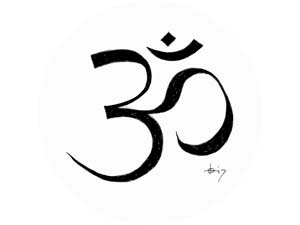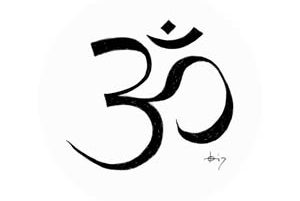Nivedita Yohana
Meditation
Meditation is a practice where an individual trains the mind or induces a mode of consciousness, either to realize some benefit or for the mind to simply acknowledge its content without becoming identified with that content, or as an end in itself.
The term meditation refers to a broad variety of practices that includes techniques designed to promote relaxation, build internal energy or life force (qi, ki, prana, etc.) and develop compassion, love, patience, generosity, and forgiveness.
It is an exercise to detach from the world and from our own personality to perceive absolute reality. A particularly ambitious form of meditation aims at effortlessly sustained single-pointed concentration meant to enable its practitioner to enjoy an indestructible sense of well-being while engaging in any life activity.
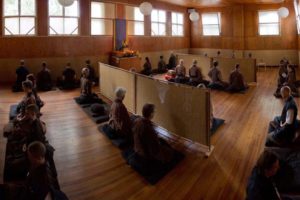
The word meditation carries different meanings in different contexts. Meditation has been practiced since antiquity as a component of numerous religious traditions and beliefs. Meditation often involves an internal effort to self-regulate the mind to observe, have a panoramic view to get an unbiased solution/conclusion, contemplate free from our conditioning and prejudice.
Meditation is often used to clear the mind and ease many health concerns, such as high blood pressure, depression, and anxiety.
It may be done sitting, or in an active way — for instance, Buddhist monks involve awareness in their day-to-day activities as a form of mind-training. Prayer beads or other ritual objects are commonly used during meditation in order to keep track of or remind the practitioner about some aspect of that training and also following a rhythm induces concentration/focus.

Meditation may involve generating an emotional state for the purpose of analyzing that state — such as anger, hatred, etc. — or cultivating a particular mental response to various phenomena, such as compassion.
The term “meditation” can refer to the state itself, as well as to practices or techniques employed to cultivate the state. Meditation may also involve repeating a mantra and closing the eyes. The mantra is chosen based on its suitability to the individual meditator.
Meditation has a calming effect and directs awareness inward until pure awareness is achieved, described as “being awake inside without being aware of anything except awareness itself”.
In brief, there are dozens of specific styles of meditation practice, and many different types of activity commonly referred to as meditative practices.
It is not only about concentration, it’s also about deconstructing our thoughts and perception in order to elevate our consciousness and awareness.
Meditation is also to quiet the ever-buzzing mind.
What are the benefits of meditation?

- A calm mind
- Good concentration
- Better clarity
- Improved communication
- Relaxation and rejuvenation of the mind and body
Health Benefits of Meditation
With meditation, the physiology undergoes a change and every cell in the body is filled with more prana (energy). This results in joy, peace, enthusiasm as the level of prana in the body increases.
On a physical level, meditation:
- Lowers high blood pressure, lowers the levels of blood lactate, reducing anxiety attacks
- Decreases any tension-related pain, such as, tension headaches, ulcers, insomnia, muscle and joint problems
- Increases serotonin production that improves mood and behaviour
- Improves the immune system
- Increases the energy level, as you gain an inner source of energy.
Mental Benefits of Meditation
Meditation brings the brainwave pattern into an alpha state that promotes healing. The mind becomes fresh, delicate and beautiful. It cleanses and nourishes you from within and calms you, whenever you feel overwhelmed, unstable, or emotionally shut down.
With regular practice of meditation:
- Anxiety decreases
- Emotional stability improves
- Creativity increases
- Happiness increases
- Intuition develops
- Gain clarity and peace of mind
- Gives a fresh perspective to the problems you are facing
- Meditation sharpens the mind by gaining focus and expands through relaxation
- A sharp mind without expansion causes tension, anger and frustration
- An expanded consciousness without sharpness can lead to lack of action/progress
- The balance of a sharp mind and an expanded consciousness brings perfection
- Meditation makes you aware — that your inner attitude determines your happiness.
There are various kinds of meditations and we must remember that all roads ultimately converge to the same destination. There are always individual choices which could be based on personal or one’s confidante’s experience, personal inclinations, one’s upbringing/background, knowledge, exposure and many more. There are no hierarchies or gradations or rankings when it comes to meditation. All kinds/forms of meditation are based on various philosophies and approaches aimed at enhancing awareness, clarity of mind, to attain calmness and balance in perception, to de-condition the mind and free it from the ignorance we unconsciously embrace. Here are some of the mediation forms, I wish to mention based on my personal choice and not on any pecking order.
Buddhist Meditation or Zen Meditation (zazen)
Origin & Meaning
Zazen means “seated Zen”, or “seated meditation”, in Japanese. It has its roots in the Chinese Zen Buddhism tradition, tracing back to Indian monk Bodhidharma (6th century CE). In the West, its most popular forms comes from Dogen Zenji the founder of Soto Zen movement in Japan. Similar modalities are practiced in the Rinzai school of Zen, in Japan and Korea.
How to do it
Find a comfortable position
It is generally practiced seated on the floor over a mat and cushion, with crossed legs. Traditionally it was done in lotus or half-lotus position, but this is hardly necessary. Nowadays most practitioners sit like this:
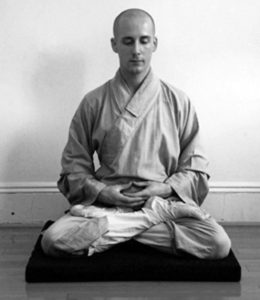 |
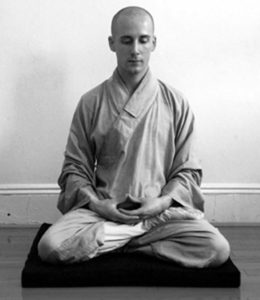 |
 |
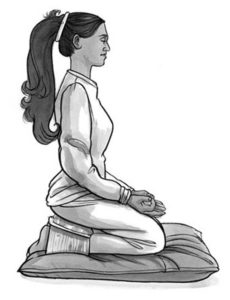 |
The most important aspect, as you see in the pictures, is keeping the back completely straight, from the pelvis to the neck. Mouth is kept close and eyes are kept lowered, with your gaze resting on the ground about two or three feet in front of you.
Mind
As to the mind aspect of it, it’s usually practiced in two ways:
- Focusing on breath — focus all your attention on the movement of the breath going in and out through the nose. This may be aided by counting the breath in your mind. Each time you inhale you count one number, starting with 10, and then moving backward to 9, 8, 7, etc. When you arrive in 1, you resume from 10 again. If you get distracted and lose your count, gently bring back the attention to 10 and resume from there.
- Shikantaza (“just sitting”) — in this form the practitioner does not use any specific object of meditation; rather, practitioners remain as much as possible in the present moment, aware of and observing what passes through their minds and around them, without dwelling on anything in particular. It’s a type of Effortless Presence
Kinhin Meditation
Kinhin, also known as the Walking meditation is the meditation practiced while walking that is practiced between long periods of the sitting meditation known as zazen. The practice is familiar in Zen, Chan Buddhism, Korean Seon and Vietnamese Thiền.
Practitioners walk behind each other clockwise around a room or in a winding row inside a building or outside in the open air.
They hold their hands in shashu: the back is straight, the head is up, and the hands are over the solar plexus. The right hand is in a loose fist with the thumb and index finger forming a ring. The left hand is over the right hand and the thumb lightly hooked into the ring of the right hand.

The pace of walking meditation may be slow (several steady steps per each breath) or brisk, almost to the point of jogging.
Anzan Hoshin roshi says in Before Thinking: Foundations of Zen Practice (2005):
“Taking a step in mindfulness is itself a presentation of the wisdom of the Buddha.”
Mindfulness Meditation
Origin and meaning
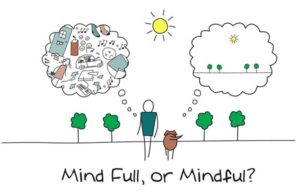
Mindfulness Meditation is an adaptation from traditional Buddhist meditation practices, especially Vipassana, but also having strong influence from other lineages (such as the Vietnamese Zen Buddhism from Thich Nhat Hanh).
“Mindfulness” is the common western translation for the Buddhist term sati. Anapanasati, “mindfulness of breathing”, is part of the Buddhist practice of Vipassana or insightful meditation, and other Buddhist meditational practices, such as zazen.
One of the main influencers for Mindfulness in the West is John Kabat-Zinn. His Mindfulness-Based Stress Reduction program (MBSR) — which he developed in 1979 at the University of Massachusetts Medical School — has been used in several hospitals and health clinic on the past decades.
How to do it
Mindfulness meditation is the practice of intentionally focusing on the present moment, accepting and non-judgmentally paying attention to the sensations, thoughts, and emotions that arise.
For the “formal practice” time, sit on a cushion on the floor, or on a chair, with straight and unsupported back. Pay close attention to the movement of your breath. When you breathe in, be aware that you are breathing in, and how it feels. When you breathe out, be aware you are breathing out. Do like this for the length of your meditation practice, constantly redirecting the attention to the breath. Or you can move on to be paying attention to the sensations, thoughts and feelings that arise.
The effort is to not intentionally add anything to our present moment experience, but to be aware of what is going on, without losing ourselves in anything that arises.
Your mind will get distracted into going along with sounds, sensations, and thoughts. Whenever that happens, gently recognize that you have been distracted, and bring the attention back to the breathing, or to the object noticing of that thought or sensation. There is a big difference between being inside the thought/sensation, and simply being aware of it’s presence.
Learn to enjoy your practice. Once you are done, appreciate how different the body and mind feel.
There is also the practice of mindfulness during our daily activities: while eating, walking, and talking. For “daily life” meditation, the practice is to pay attention to what is going on in the present moment, to be aware of what is happening — and not living in “automatic mode”. If you are speaking, that means paying attention to the words you speak, how you speak them, and to listen with presence and attention. If you are walking, that means being more aware of your body movements, your feet touching the ground, the sounds you are hearing, etc.
Your effort in seated practice supports your daily life practice, and vice-versa. They are both equally important.
Loving Kindness Meditation (Metta Meditation)
Origin and meaning
Metta is a Pali word that means kindness, benevolence, and good will. This practice comes from the Buddhist traditions, especially the Theravada and Tibetan lineages. “Compassion meditation” is a contemporary scientific field that demonstrates the efficacy of metta and related meditative practices.
Demonstrated benefits include: boosting one’s ability to empathize with others; development of positive emotions through compassion, including a more loving attitude towards oneself; increased self-acceptance; greater feeling of competence about one’s life; and increased feeling of purpose in life (read more in our other post which post?).
How to do it
One sits down in a meditation position, with closed eyes, and generates in his mind and heart feelings of kindness and benevolence. Start by developing loving-kindness towards yourself, then progressively towards others and all beings. Usually this progression is advised:
- oneself
- a good friend
- a “neutral” person
- a difficult person
- all four of the above equally
- and then gradually the entire universe
The feeling to be developed is that of wishing happiness and well-being for all. This practice may be aided by reciting specific words or sentences that evoke the “boundless warm-hearted feeling”, visualizing the suffering of others and sending love; or by imagining the state of another being, and wishing him happiness and peace.
The more you practice this meditation, the more joy you will experience. That is the secret of Mathieu Richard’s happiness.
Yoga Meditations
Origin and meaning
OM yogic meditations. There is not one type of meditation which is “Yogic Meditation”, so here it is meant the several meditation types taught in the yoga tradition. Yoga means “union”. Tradition goes as far as 1700 BC, and has as its highest goal spiritual purification and Self-Knowledge. Classical Yoga divides the practice into rules of conduct (yamas and niyamas), physical postures (asanas), breathing exercises (pranayama), and contemplative practices of meditation (pratyahara, dharana, dhyana, samadhi).
The Yoga tradition is the oldest meditation tradition on earth, and also the one with the widest variety of practices.
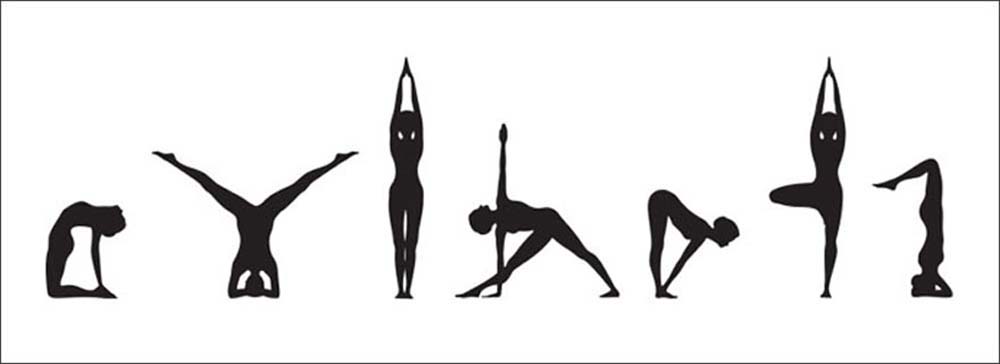
How to do it
Here are some types of meditation practiced in Yoga. The most common and universal Yoga meditation one is the “third eye meditation”. Other popular ones involve concentrating on a chakra, repeating a mantra, visualization of light, or gazing meditations.
Third Eye Meditation
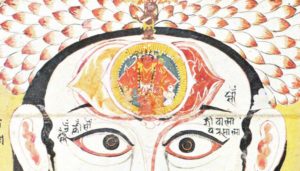
Focusing the attention on the “spot between the eyebrows” (called by some “the third eye” or “ajna chakra”). The attention is constantly redirected to this point, as a means to silence the mind. By time the “silent gaps” between thoughts get wider and deeper. Sometimes this is accompanied by physically “looking”, with eyes closed, towards that spot.
Chakra Meditation
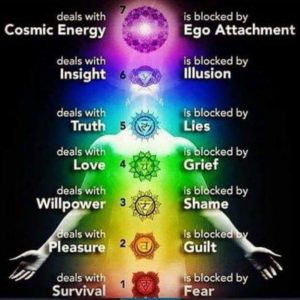
The practitioner focuses on one of the seven chakras of the body (“centers of energy”), typically doing some visualizations and chanting a specific mantra for each chakra (lam, vam, ram, yam, ham, om). Most commonly it is done on the heart (anahata) chakra, third eye, and crown chakra.
Gazing Meditation (Trataka)
Fixing the gaze on an external object, typically a candle, image or a symbol (yantras). It is done with eyes open, and then with eyes closed, to train both the concentration and visualization powers of the mind. After closing the eyes, you should still keep the image of the object in your “mind’s eye”. This meditation is so important and powerful, that I wrote this post on the subject.
Kundalini Meditation
This is a very complex system of practice. The goal is the awakening of the “kundalini energy” which lies dormant on the base of the spine, the development of several psychic centers in the body, and, finally, enlightenment.
There are several dangers associated with this practice, and it should not be attempted without the guidance of a qualified yogi. Kundalini is only concerned with truth and authenticity. When we have the courage to face the truth about ourselves and our lives, the truth sets us free. Kundalini can then work the way it was designed to. Without self-awareness work Kundalini continues to affect the nervous system in various ways without reaching its ultimate goal of spiritual awakening and self-realization.
Kriya Yoga
Kriya Yoga is a set of energization, breathing, and meditation exercises taught by Paramahansa Yogananda. This is more suited for those who have a devotional temperament, and are seeking the spiritual aspects of meditation.
To learn it, you can apply to receive the Self-Realization lessons, free of charge.
Sound Meditation (Nada Yoga)
Nada Yoga is focusing on sound. Starts with meditation on “external sounds”, such as calming ambient music (like Native American flute music), whereby the student focuses all his attention on just hearing, as a help to quieten and collect the mind.
By time the practice evolves to hearing the “internal sounds” of the body and mind. The ultimate goal is to hear the “Ultimate Sound” (para nada), which is a sound without vibration, and that manifests as “OM”.
Tantra
Unlike the popular view in the West, most Tantra practices have nothing to do with ritualized sex (this was practiced by a minority of lineages).
Tantra is a very rich tradition, with dozens of different contemplative practices. The text Vijnanabhairava Tantra, for instance, lists 108 “meditations”, most of them more advanced (already requiring a certain degree of stillness and mind control).

Here are some examples from that text:
Merge the mind and the senses in the interior space in the spiritual heart. When one object is perceived, all other objects become empty. Concentrate on that emptiness. Concentrate on the space which occurs between two thoughts. Fix attention on the inside of the skull. Close eyes. Meditate on the occasion of any great delight. Meditate on the feeling of pain. Dwell on the reality which exists between pain and pleasure. Meditate on the void in one’s body extending in all directions simultaneously. Concentrate on a bottomless well or as standing in a very high place.
Listen to the Anahata [heart chakra]sound. Listen to the sound of a musical instrument as it dies away. Contemplate on the universe or one’s own body as being filled with bliss. Concentrate intensely on the idea that the universe is completely void. Contemplate that the same consciousness exists in all bodies.
Pranayama — breathing regulation
It is not exactly meditation, but an excellent practice to calm the mind and prepare it for meditation.
There are several different types of Pranayama, but the simplest and most commonly taught one is the 4-4-4-4. This means breathing in counting up to 4, holding for 4 seconds, breathing out for 4 seconds, and holding empty for 4 seconds. Breathe through your nose, and let the abdomen (and not the chest) be the one that moves. Go through a few cycles like this. This regulation of breathing balances the moods and pacifies the body, and can be done anywhere.
Yoga is a very rich tradition, with different lineages, so there are many other techniques. But the ones above are the most well-known; the others are more specific or complex.
We need to silence
Meditation serves as a tool/window to our soul which possesses the eternal wisdom.
In order to find peace, tranquility, solutions to our endless problems, to get answers to our confusions and perplexities that life hurls at us, to understand ourselves better, to wake up from our auto pilot mode of living, to get out of our daily grind and start living with awareness and consciousness — we need to silence.
Silence the ever buzzing cell phones, ever chattering voices in our head; replaying unpleasant experiences and overly stimulated sensory experiences that capitalistic world has sucked us all into.
It does remind me of Rudyard Kipling’s poem[12]
If you can keep your head when all about you
Are losing theirs and blaming it on you,
If you can trust yourself when all men doubt you,
But make allowance for their doubting too;
If you can wait and not be tired by waiting,
Or being lied about, don’t deal in lies,
Or being hated, don’t give way to hating,
And yet don’t look too good, nor talk too wise:
If you can dream — and not make dreams your master;
If you can think — and not make thoughts your aim;
If you can meet with Triumph and Disaster
And treat those two impostors just the same;
If you can bear to hear the truth you’ve spoken
Twisted by knaves to make a trap for fools,
Or watch the things you gave your life to, broken,
And stoop and build ’em up with worn-out tools:
If you can make one heap of all your winnings
And risk it on one turn of pitch-and-toss,
And lose, and start again at your beginnings
And never breathe a word about your loss;
If you can force your heart and nerve and sinew
To serve your turn long after they are gone,
And so hold on when there is nothing in you
Except the Will which says to them: ‘Hold on!’
If you can talk with crowds and keep your virtue,
Or walk with Kings — nor lose the common touch,
If neither foes nor loving friends can hurt you,
If all men count with you, but none too much;
If you can fill the unforgiving minute
With sixty seconds’ worth of distance run,
Yours is the Earth and everything that’s in it,
And — which is more — you’ll be a Man, my son!
To be centered and calm, we need to step out of our own comfort zone and dare to challenge our preconceptions, prejudice and conditionings.
It’s quite a challenge to be brutally honest with ourselves which involves tearing down the wall of defense which we have meticulously built around our ego and face the soul.
To attain calmness and centeredness, we need to first face the storm of our own resentments, hatred and vicious patterns that engulfs us.
When the glass has a blemish, whatever we see and perceive through it, will be smudged and deceptive as well so in the same way our mind is like a glass — clearer mind always grasps and discerns the information better devoid of negativity.
If we must perceive higher dimension of reality and access our soul then meditation with the intention of understanding ourselves is vital.
Meditation is not just about sitting in silence but also to be aware of our own thoughts and contemplate on our day-to-day reactions towards others with fairness, detachment and impartially.
It is crucial to be aware of our negativity as it can sneak up on us if we are not aware.
We often justify our anger, prejudice, resentments and play victim to feel superior or to protect our ego hence it is paramount to be unbiased not only with ourselves but also with the world around.
Thus, meditation done with right attitude can open doors to higher awareness and can really enrich our lives and make life worthwhile.
- Anderson, M. (2004). Mindfulness Meditation. Australia: Australian Institute of Emotional Intelligence.
- Buddhist meditation. (1983). Leicester (P.O. Box 136, Leicester, LE2 4TZ): Buddhist Pub. Group.
- Chilson, R. (2004). Meditation. Notre Dame, IN: Sorin Books.
- Dispenza, J., & Amen, D.G. (2015). Breaking the habit of being yourself: How to lose your mind and create a new one. Carlsbad, CA: Hay House.
- Mercado-Lugo, R.E. (2007). Consiousness.
- Kipling, R., Gillooly, E., & Sharpe, J. (2000). Rudyard Kipling. New York: Sterling.
- Ozaniec, N. (2007). Meditation. London: Teach Yourself.
- (1972). Pranayama. Jaipur: Sanskriti Prakashan.
- Sturgess, S. (2014). Yoga meditation. Watkins Publishing.
- Osho (2007) The Spiritual Path: Buddha Zen Tao Tantra. Lewes: Ivy.
- Roshi, Anzan Hoshin (2005) Before Thinking: Foundations of Zen Practice. Great Matter Publications.
- Woodroffe, J.G. (1993). The great liberation (Mahānirvāṇa Tantra). Madras: Ganesh and Company.
Notes
[1] Source: what is zen
[2] Source: Kinhin
[3] Source: benefits-of-meditation-did-you-know-key-facts-about-meditation
[4] Source: how-to-meditate
[5] Source: preparing-for-meditation-sitting-still
[6] Source: hands in shashu
[7] Source: Mind full or mindful?
[8] Source: Yoga asanas
[9] Source: Brow Chakra Rajasthan 18th Century
[10] Source: The seven chakras
[11] Source: Anahata (heart) Chakra
[12] Source: poems: if…

